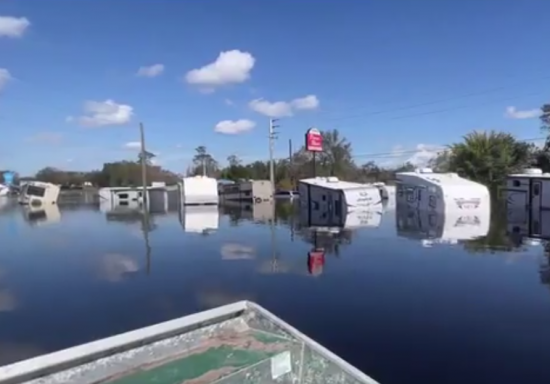The latest

Hurricane Ian flooding along the Peace River in Arcadia, Florida, October 7, 2022. Courtesy, DeSoto County Sheriff’s Office
On this 12th day since Hurricane Ian struck Florida, all signs continue to point to this being more of a flood than a wind event in terms of total insurance claims. Along its path 92 Floridians lost their lives. The high-end Category 4 storm packing 155 mph winds made landfall on North Captiva Island dumping a high of 14.4 inches of rain in Lee County along with a storm surge that topped 12 feet in some areas. Charlotte County received 18-20 inches. Ian headed north across inland Florida, with torrential rainfall totals of nearly two feet in Arcadia in DeSoto County, 12 inches in Ona near Wauchula in Hardee County, 17 inches in Lake Wales in Polk County, 15 inches in Orlando, and 21 inches in New Smyrna Beach with up to 96 mph winds, south of Daytona Beach, where Ian emerged into the Atlantic Ocean before heading to the Carolinas. Many adjoining counties to the north and south of its path received double-digit inches of rain that 24 hour period, causing widespread river and stream flooding, leaving many neighborhoods with moderate to severe flooding. Flash flood warnings remained active up to a week later. At latest count this past weekend:
- Florida insurance regulators reported $3.89 billion in total estimated insured losses on 428,739 claims. Estimated claims are expected to number between 850,000 to 1 million (see chart below);
- FEMA’s National Flood Insurance Program (NFIP) reported 25,000 claims and has issued more than $17 million in advance payments;
- FEMA has paid out $168 million through applications for Individual Assistance grants, which help with home repair and replacing personal belongings;
- State-backed Citizens Property Insurance estimates its losses at $2.3 billion to $2.6 billion.

From Florida Office of Insurance Regulation
A multitude of national modeling analysis companies have put initial estimated insured losses at between $32 billion to $63 billion. A Verisk analysis estimates total insurance/reinsurance losses between $42 billion to $57 billion, with 99% of that in Florida and 1% in South Carolina. It said the majority of the insured losses will be from wind damage ($38 billion to $51 billion); however, it did not include NFIP flood losses. That and other factors could push the total to exceed $60 billion. It also doesn’t include uninsured property or infrastructure losses (another modeler has put uninsured losses at $10B). Storm surge (excluding NFIP losses) account for $3 billion to $5.5 billion of the loss estimate, and inland flood less than $1 billion.
Florida’s second biggest industry of agriculture (behind only tourism) suffered extensive losses. Hurricane Ian traveled directly over 4 of the 5 largest citrus-producing counties of Florida with winds as high as 140 mph. Up to 80% of the crop was destroyed in some areas. Ian’s flooding caused public water and sewer systems to fail in Lee and Orange counties, with the Orlando region’s sewage systems failing, swamping homes and lakes with wastewater.
At last report yesterday (October 9), 46,481 households were still without electricity. The Sanibel & Captiva Islands, the last of the barrier beaches to have vehicular traffic restored to the mainland, are scheduled to have a temporary bridge in service by month’s end.
LMA Newsletter of 10-10-22

